
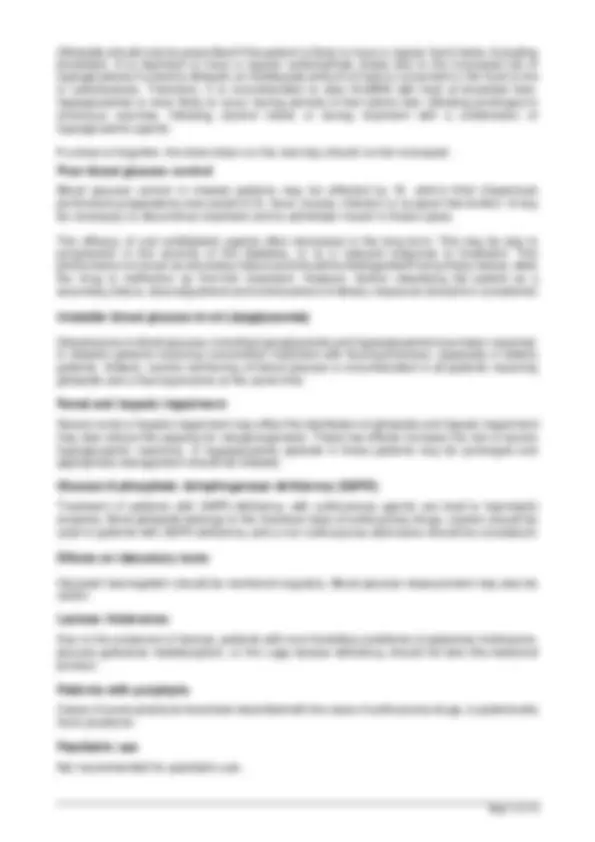
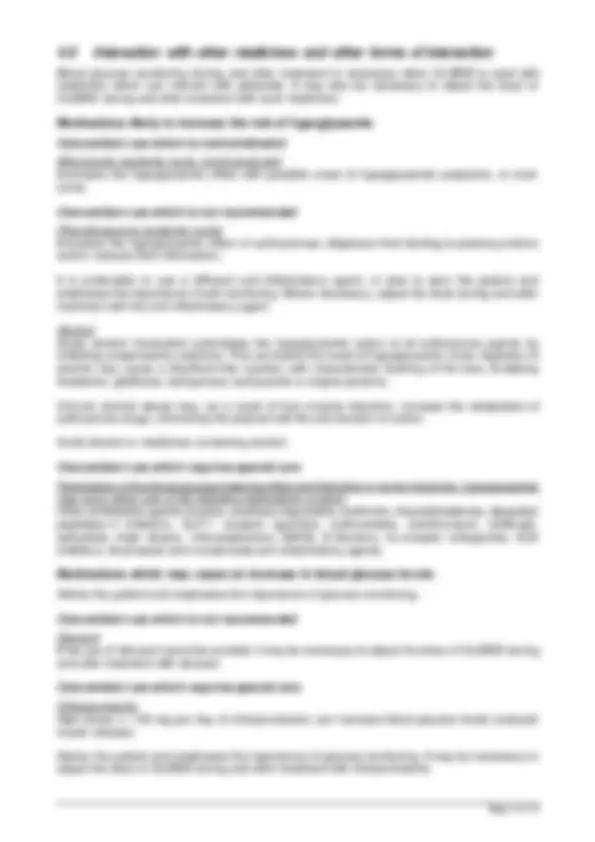
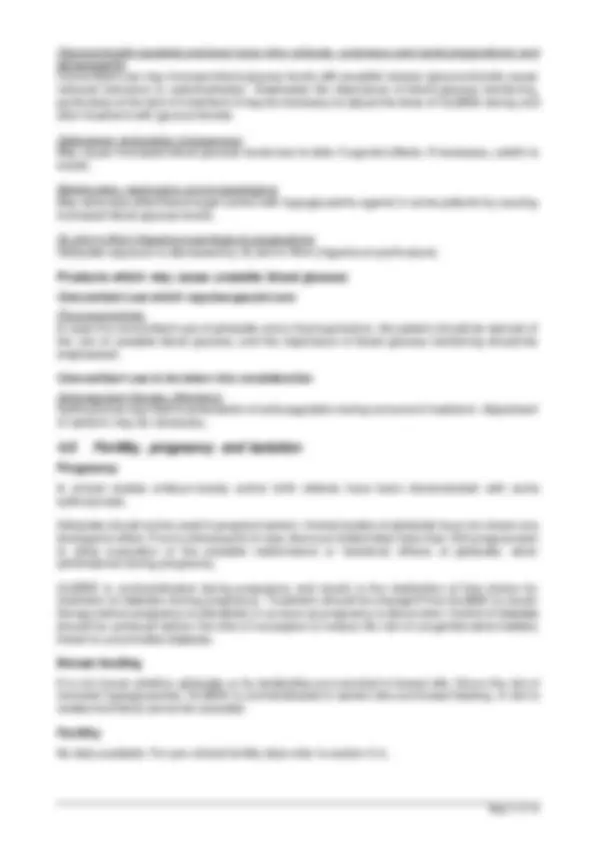
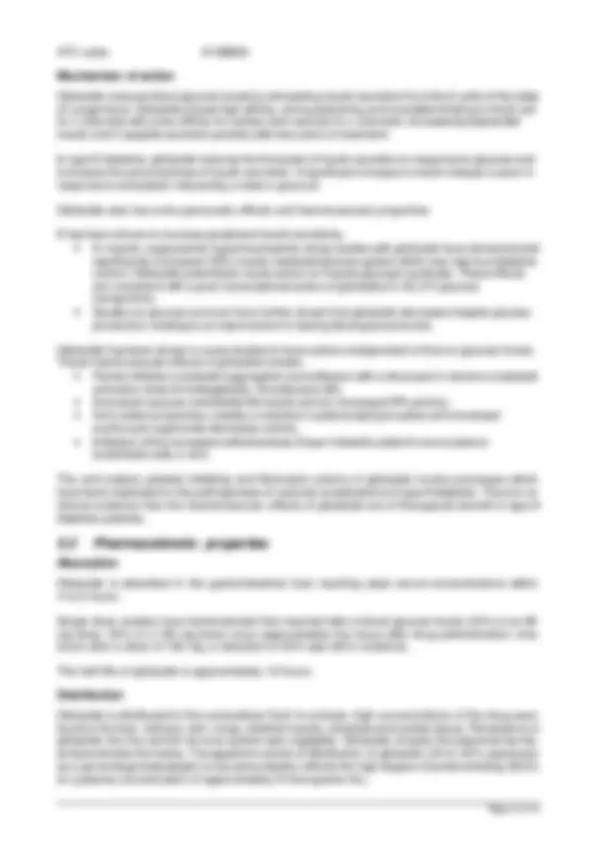
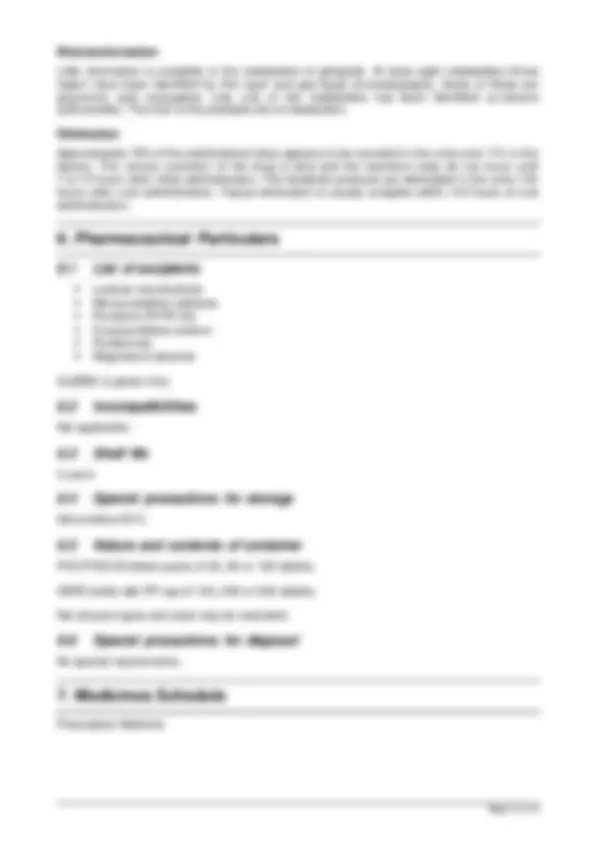
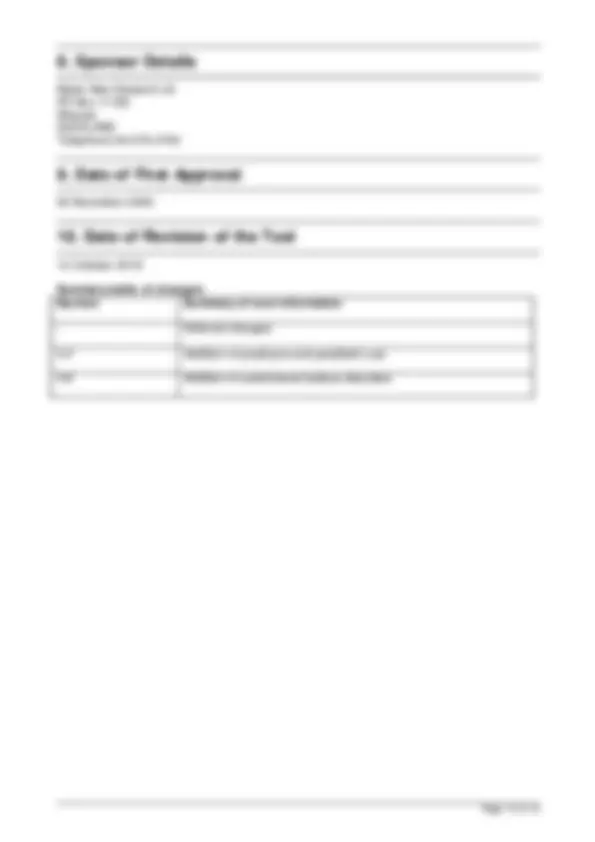


Study with the several resources on Docsity

Earn points by helping other students or get them with a premium plan


Prepare for your exams
Study with the several resources on Docsity

Earn points to download
Earn points by helping other students or get them with a premium plan
Community
Ask the community for help and clear up your study doubts
Discover the best universities in your country according to Docsity users
Free resources
Download our free guides on studying techniques, anxiety management strategies, and thesis advice from Docsity tutors
Information on the dosage, method of administration, warnings, precautions, interactions, and pharmacological properties of the antidiabetic drug Gliclazide. It covers topics such as optimal control, monitoring diabetic state, transferring to Gliclazide, risk factors for hypoglycaemia, poor blood glucose control, unstable blood glucose levels, interaction with other medicines, and effects on ability to drive and use machines. It also includes information on adverse effects and contraindications.
What you will learn
Typology: Study notes
1 / 10

This page cannot be seen from the preview
Don't miss anything!







GLIZIDE, 80 mg tablets.
Each GLIZIDE tablet contains 80 mg gliclazide.
Excipient with known effect: Each GLIZIDE tablet contains 110 mg of lactose monohydrate.
For the full list of excipients, see section 6.1.
GLIZIDE 80 mg tablets are white to off white, circular, flat, beveled edged, uncoated tablets with a breakline on one side and “80” on the reverse.
The tablet can be divided into equal doses.
Diabetes mellitus of the maturity onset type, which cannot be controlled by diet alone.
The dosage of gliclazide should be carefully titrated to maintain optimal control at the various possible dose levels. Dosage should be initiated at 40 mg (1/2 tablet) daily and may be increased if necessary up to 320 mg (4 tablets) daily. Doses up to 160 mg daily may be taken in a single dose but preferably at the same time each morning. Doses in excess of 160 mg should be taken in divided doses in the morning and evening.
The dosage will depend on the severity of the glycaemia with ongoing adjustments made in order to obtain the optimal response at the lowest dosage.
Treatment with gliclazide does not obviate the necessity of maintaining standard dietary requirements.
This medication is contraindicated in the following cases:
Hypersensitivity to gliclazide, other sulfonylureas, sulfonamides, or to any of the excipients listed in section 6. Type I diabetes, diabetic keto-acidosis, diabetic pre-coma and coma Severe renal or hepatic impairment: in these cases the use of insulin is recommended
Treatment with miconazole (see section 4.5) Pregnancy and lactation (see section 4.6)
It is generally not recommended to use this agent in combination with phenylbutazone or danazol (see section 4.5).
As with other antidiabetic therapies, patients must be under close medical supervision. Particular care must be taken during the initial period of stabilisation. Patients treated with gliclazide should be monitored regularly to ensure optimal control of the diabetic state, and where necessary, for adjustment of dosage.
Patients who have been previously treated with sulfonylureas or biguanides alone or in combination may be transferred to gliclazide. When gliclazide is administered as sole therapy to patients who have previously required combination therapy (e.g. biguanides and sulfonylureas), careful observation is essential during the transitional phase.
It is not generally recommended that insulin treated patients be transferred to gliclazide.
Comprehensive instructions must be given to the patient about the nature of the disease and what must be done to detect and prevent complications.
These acute complications provoke additional metabolic stress which accentuates the predisposition to hyperglycaemia and ketosis. Patients presenting with such conditions may require insulin to maintain control. It is not appropriate to increase the dosage of gliclazide.
The risks of hypoglycaemia, together with its symptoms, treatment and conditions that predispose to its development, should be explained to the patient and to family members. The patient should be informed of the importance of following dietary advice, of taking regular exercise, and of regular monitoring of blood glucose levels.
Hypoglycaemia may occur following administration of sulfonylureas. Rarely cases may be severe and prolonged. This may involve hospitalisation and glucose infusion may need to be continued for several days.
Careful selection of patients and of the dose used, as well as provision of adequate information to the patient are necessary to avoid hypoglycaemic episodes.
The following factors may increase the risk of hypoglycaemia:
patient does not follow the doctor’s treatment advice (particularly elderly patients); malnutrition; irregular mealtimes, skipping meals, periods of fasting or dietary changes; imbalance between physical exercise and carbohydrate intake; renal impairment; severe hepatic impairment; overdose of anti-diabetic agents; certain endocrine disorders: thyroid disorders, hypopituitarism and adrenal impairment, concomitant administration of certain other medicines (see section 4.5).
Blood glucose monitoring during and after treatment is necessary when GLIZIDE is used with medicines which can interact with gliclazide. It may also be necessary to adjust the dose of GLIZIDE during and after treatment with such medicines.
Concomitant use which is contraindicated
Miconazole (systemic route, oromucosal gel) Increases the hypoglycaemic effect with possible onset of hypoglycaemia symptoms, or even coma.
Concomitant use which is not recommended
Phenylbutazone (systemic route) Increases the hypoglycaemic effect of sulfonylureas (displaces their binding to plasma proteins and/or reduces their elimination).
It is preferable to use a different anti-inflammatory agent, or else to warn the patient and emphasise the importance of self-monitoring. Where necessary, adjust the dose during and after treatment with the anti-inflammatory agent.
Alcohol Acute alcohol intoxication potentiates the hypoglycaemic action of all sulfonylurea agents by inhibiting compensatory reactions. This can lead to the onset of hypoglycaemic coma. Ingestion of alcohol may cause a disulfiram-like reaction with characteristic flushing of the face, throbbing headache, giddiness, tachypnoea, tachycardia or angina pectoris.
Chronic alcohol abuse may, as a result of liver enzyme induction , increase the metabolism of sulfonylurea drugs, shortening the plasma half-life and duration of action.
Avoid alcohol or medicines containing alcohol.
Concomitant use which requires special care
Potentiation of the blood glucose lowering effect and therefore in some instances, hypoglycaemia may occur when one of the following medications is taken Other antidiabetic agents (insulins, acarbose, biguanides, metformin, thiazolidinediones, dipeptidyl peptidase-4 inhibitors, GLP-1 receptor agonists), sulfonamides, clarithromycin, clofibrate, salicylates (high doses), chloramphenicol, MAOIs, β-blockers, H 2 -receptor antagonists, ACE inhibitors, fluconazole and nonsteroidal anti-inflammatory agents.
Advise the patient and emphasise the importance of glucose monitoring.
Concomitant use which is not recommended
Danazol If the use of danazol cannot be avoided, it may be necessary to adjust the dose of GLIZIDE during and after treatment with danazol.
Concomitant use which requires special care
Chlorpromazine High doses (> 100 mg per day of chlorpromazine) can increase blood glucose levels (reduced insulin release).
Advise the patient and emphasise the importance of glucose monitoring. It may be necessary to adjust the dose of GLIZIDE during and after treatment with chlorpromazine.
Glucocorticoids (systemic and local route: intra-articular, cutaneous and rectal preparations) and tetracosactrin Concomitant use may increase blood glucose levels with possible ketosis (glucocorticoids cause reduced tolerance to carbohydrates). Emphasise the importance of blood glucose monitoring, particularly at the start of treatment. It may be necessary to adjust the dose of GLIZIDE during and after treatment with glucocorticoids.
Salbutamol, terbutaline (intravenous) May cause increased blood glucose levels due to beta-2 agonist effects. If necessary, switch to insulin.
Barbiturates, oestrogens and progestogens May adversely affect blood sugar control with hypoglycaemic agents in some patients by causing increased blood glucose levels.
St John's Wort (Hypericum perforatum) preparations Gliclazide exposure is decreased by St John's Wort (Hypericum perforatum).
Concomitant use which requires special care
Fluoroquinolones In case of a concomitant use of gliclazide and a fluoroquinolone, the patient should be warned of the risk of unstable blood glucose, and the importance of blood glucose monitoring should be emphasised.
Concomitant use to be taken into consideration
Anticoagulant therapy (Warfarin) Sulfonylureas may lead to potentiation of anticoagulation during concurrent treatment. Adjustment of warfarin may be necessary.
In animal studies embryo-toxicity and/or birth defects have been demonstrated with some sulfonylureas.
Gliclazide should not be used in pregnant women. Animal studies of gliclazide have not shown any teratogenic effect. From a clinical point of view, there are limited data (less than 300 pregnancies) to allow evaluation of the possible malformative or foetotoxic effects of gliclazide, when administered during pregnancy.
GLIZIDE is contraindicated during pregnancy and insulin is the medication of first choice for treatment of diabetes during pregnancy. Treatment should be changed from GLIZIDE to insulin therapy before pregnancy is attempted, or as soon as pregnancy is discovered. Control of diabetes should be achieved before the time of conception to reduce the risk of congenital abnormalities linked to uncontrolled diabetes.
It is not known whether gliclazide or its metabolites are excreted in breast milk. Giv en the risk of neonatal hypoglycaemia, GLIZIDE is contraindicated in women who are breast feeding. A risk to newborns/infants cannot be excluded.
No data available. For pre-clinical fertility data refer to section 5.3.
Blood and lymphatic system disorders (as with other sulfonylurea medications) Anaemia, leucopenia, thrombocytopenia and agranulocytosis. These are in general reversible upon discontinuation of medication.
Hepatobiliary disorders Elevations of serum bilirubin and hepatic enzymes (AST, ALT, alkaline phosphatase) levels, and exceptionally, hepatitis (isolated reports). Treatment should be discontinued if cholestatic jaundice appears. These symptoms usually disappear after discontinuation of treatment.
Investigations Occasional elevations of serum creatinine, blood urea nitrogen.
Eye disorders Transient visual disturbances may occur due to changes in blood glucose levels, particularly on initiation of treatment. As with any glucose-lowering medication, transient visual disturbances may occur on initiation of treatment due to changes in blood glucose levels.
The following adverse events have been observed with sulfonylureas Cases of erythrocytopenia, agranulocytosis, haemolytic anaemia, pancytopenia and allergic vasculitis, hyponatremia, elevated liver enzyme levels and even impairment of liver function (e.g. with cholestasis and jaundice) and hepatitis which regressed after withdrawal of the sulfonylurea or led to life-threatening liver failure in isolated cases.
Reporting of suspected adverse reactions
Reporting suspected adverse reactions after authorisation of the medicine is important. It allows continued monitoring of the benefit/risk balance of the medicine. Healthcare professionals are asked to report any suspected adverse reactions https://nzphvc.otago.ac.nz/reporting/.
Overdose of sulfonylureas may cause hypoglycaemia.
Moderate symptoms of hypoglycaemia (without loss of consciousness or neurological signs), should be corrected by carbohydrate intake, dose adjustment and/or modification of diet. Strict monitoring should be continued until the doctor is sure that the patie nt is out of danger.
Severe hypoglycaemic reactions are possible (with coma, convulsions or other neurological disorders) and should be treated as a medical emergency, requiring immediate hospitalisation.
If hypoglycaemic coma is diagnosed or suspected, the patient should be given a rapid I.V. injection of 50 mL of concentrated glucose solution (20 to 30%). This should be followed by continuous infusion of a more dilute glucose solution (10%) at a rate necessary to maintain blood glucose levels above 5 mmol/L. It is recommended that patients should be monitored closely for a 48 hour period at least.
Plasma clearance of gliclazide may be prolonged in patients with hepatic disease. However, due to the strong binding of gliclazide to proteins, dialysis is not e ffective in these patients.
For further advice on management of overdose please contact the National Poisons Information Centre (0800 POISON or 0800 764 766).
Pharmacotherapeutic group:sulphonamides, urea derivatives
ATC code: A10BB
Gliclazide reduces blood glucose levels by stimulating insulin secretion from the β-cells of the islets of Langerhans. Gliclazide shows high affinity, strong selectivity and reversible binding to the β-cell KATP channels with a low affinity for cardiac and vascular KATP channels. Increased postprandial insulin and C-peptide secretion persists after two years of treatment.
In type II diabetes, gliclazide restores the first peak of insulin secretion in response to glucose and increases the second phase of insulin secretion. A significant increase in insulin release is seen in response to stimulation induced by a meal or glucose.
Gliclazide also has extra-pancreatic effects and haemovascular properties.
It has been shown to increase peripheral insulin sensitivity: In muscle, euglycaemic hyperinsulinaemic clamp studies with gliclazide have demonstra ted significantly increased (35%) insulin mediated glucose uptake which may improve diabetes control. Gliclazide potentiates insulin action on muscle glycogen synthase. These effects are consistent with a post-transcriptional action of gliclazide on GLUT4 glucose transporters. Studies on glucose turnover have further shown that gliclazide decreases hepatic glucose production, leading to an improvement in fasting blood glucose levels.
Gliclazide has been shown in some studies to have actions independent of that on glucose levels. These haemovascular effects of gliclazide include: Partial inhibition of platelet aggregation and adhesion with a decrease in markers of platelet activation (beta thromboglobulin, thromboxane B2). Increased vascular endothelial fibrinolytic activity (increased tPA activity). Anti-oxidant properties, notably a reduction in plasma lipid peroxides and increased erythrocyte superoxide dismutase activity. Inhibition of the increased adhesiveness of type II diabetic patient’s monocytes to endothelial cells in vitro.
The anti-oxidant, platelet inhibiting and fibrinolytic actions of gliclazide involve processes which have been implicated in the pathogenesis of vascular complications of type II diabetes. There is no clinical evidence that the haemovascular effects of gliclazide are of therapeutic benefit in type II diabetes patients.
Gliclazide is absorbed in the gastrointestinal tract reaching peak serum concentrations within 4 to 6 hours.
Single dose studies have demonstrated that maximal falls in blood glucose levels (23% of an 80 mg dose; 30% of a 160 mg dose) occur approximately five hours after drug administration; nine hours after a dose of 160 mg, a reduction of 20% was still in evidence.
The half-life of gliclazide is approximately 12 hours.
Gliclazide is distributed to the extracellular fluid. In animals, high concentrations of the drug were found in the liver, kidneys, skin, lungs, skeletal muscle, intestinal and cardiac tissue. Penetrati on of gliclazide into the central nervous system was negligible. Gliclazide crosses the placental barrier and penetrates the foetus. The apparent volume of distribution of gliclazide (20 to 40% expressed as a percentage bodyweight) is low and probably reflects the high degree of protein binding (94.2% at a plasma concentration of approximately 8 micrograms/mL).
Mylan New Zealand Ltd PO Box 11183 Ellerslie AUCKLAND Telephone 09-579-
02 November 2006
14 October 2019
Summary table of changes Section Summary of new information
4.4 Addition of porphyria and paediatric use
4.8 Addition of autoimmune bullous disorders